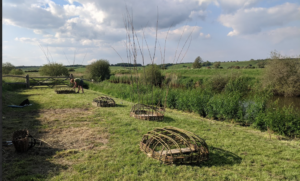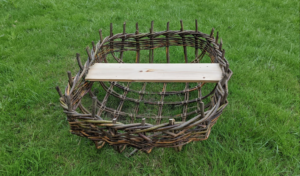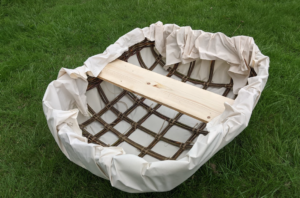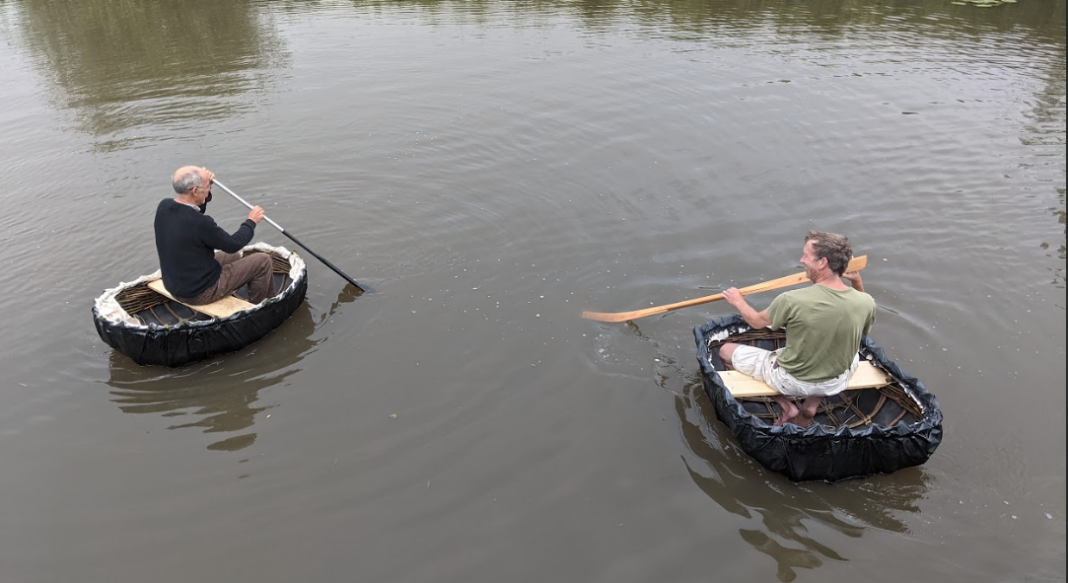As a willow weaver and basketmaker I always got my weaving materials from commercial growers in Somerset. However over the last 8 years or so my partner, James, and I have planted around twenty varieties of willow, here at Marsh Willow at Iden Lock. It is all harvested annually in the winter. Some varieties grow 3 – 5ft in a year while others will grow up to 15ft. In spring we begin to see new shoots growing on the bare stumps in our willow plantation.
Some of the winter harvest is kept alive in water when harvested and at this time of year, when leaves start to sprout on the rods, the bark can be stripped off easily giving lovely white rods that can be used to weave with. We do this by pulling the willow through a willow ‘brake’. A brake has two bits of metal that the willow rods rub against and in the process the bark comes off.

Most of the rest of the winter’s harvest has been moved under shelter to dry. Once dry, it can be stored indoors until used. The dry willow has to be soaked to make it flexible enough for basketry work. If it is used when it is freshly cut it will shrink as it dries and the weaving will become loose. There is a small window of time in the spring, however when the willow has dried just enough. It is still flexible but won’t shrink anymore as it dries completely.
We tend to use this time to make things that use the bigger varieties we grow. Willow that is too big to fit into the soaking tank, and is also too big to store indoors. Things like hurdles and plant supports. Living next to the River Rother coracles seemed like an obvious choice for some of the bigger willow too. Coracles are small woven boats and we now have a small family of them here and teach others how to make them.


Along with dug out canoes, coracles are probably the oldest design of boat. There are many coracle designs from around the world, but they are all generally roundish in shape and have a woven frame made from local materials that is somehow made waterproof. The design we use is based on an Irish Boyne coracle that uses whole rods of willow or hazel. The frame is made upside down by sticking rods in the ground, weaving around them and then bending and tying the rods to make the base of the coracle. It is then pulled out of the ground and covered with calico and painted with bitumastic paint to make it waterproof.
In many parts of the UK we know that coracles were made from woven slaths of wood rather than whole rods and some of these are still made and used today by fishermen in Wales and Shropshire. Use of whole rods is a more primitive way of making coracles and it is likely that before the advancement of carpentry skills all early coracles in the UK used whole rods like the Boyne coracle. Unfortunately, like for baskets in general, due to the biodegradable nature of the materials used the evidence for this is sparse.

I like to think that with all the waterways and estuarine channels that have criss-crossed the Romney Marsh, and the other low-lying areas around Rye. there would have been a history of coracle use here before proper boat building skills existed.
Image Credits: Julie Gurr .



